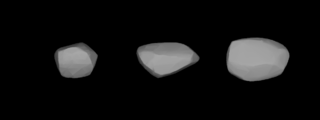Related Research Articles

26 Proserpina is a main-belt asteroid discovered by German astronomer R. Luther on May 5, 1853. It is named after the Roman goddess Proserpina, the daughter of Ceres and the Queen of the Underworld. Another main-belt asteroid, 399 Persephone, discovered in 1895, is named after her Greek counterpart. Its historical symbol was a star inside a pomegranate; it is in the pipeline for Unicode 17.0 as U+1CECD .

34 Circe is a large, very dark main-belt asteroid. It was discovered by French astronomer J. Chacornac on April 6, 1855, and named after Circe, the bewitching queen of Aeaea island in Greek mythology.

74 Galatea is a large C-type main-belt asteroid. Its carbonaceous surface is very dark in color with an albedo of just 0.034. Galatea was found by the prolific comet discoverer Ernst Tempel on August 29, 1862, in Marseilles, France. It was his third asteroid discovery. It is named after one of the two Galateas in Greek mythology. A stellar occultation by Galatea was observed on September 8, 1987. The name Galatea has also been given to one of Neptune's satellites.

143 Adria is a fairly large main-belt asteroid that was discovered by Austrian astronomer Johann Palisa on 23 February 1875, at the Austrian Naval Observatory, and named after the Adriatic Sea, on the coast of which the discovery was made. This dark-coloured asteroid has probably a primitive carbonaceous chondritic composition.

167 Urda is a main-belt asteroid that was discovered by German-American astronomer Christian Heinrich Friedrich Peters on August 28, 1876, in Clinton, New York, and named after Urd, one of the Norns in Norse mythology. In 1905, Austrian astronomer Johann Palisa showed that the asteroid varied in brightness.
256 Walpurga is a large Main belt asteroid. It was discovered by Johann Palisa on 3 April 1886 in Vienna and was named after Saint Walburga.

272 Antonia is a main belt asteroid that was discovered by French astronomer Auguste Charlois on 4 February 1888 in Nice.
408 Fama is a typical main belt asteroid in orbit around the Sun. It was discovered by German astronomer Max Wolf on 13 October 1895 in Heidelberg.
419 Aurelia is a main-belt asteroid that was discovered by German astronomer Max Wolf on September 7, 1896, in Heidelberg. It is classified as an F-type asteroid.
539 Pamina is a minor planet orbiting the Sun in the main belt. It is named for the heroine of Mozart's opera, The Magic Flute. This asteroid was discovered by M. Wolf in 1904 at the Heidelberg observatory in Germany. It is orbiting at a distance of 2.74 AU from the Sun, with an orbital eccentricity (ovalness) of 0.212 and a period of 4.53 yr. The orbital plane is inclined at an angle of 6.8° to the ecliptic.
568 Cheruskia is a minor planet, specifically an asteroid orbiting in the asteroid belt that was discovered by German astronomer Paul Götz on 26 July 1905 from Heidelberg.

573 Recha is a minor planet, specifically an asteroid orbiting in the asteroid belt between Mars and Jupiter. The asteroid, discovered by German astronomer Max Wolf on September 19, 1905, was named after a character in Gotthold Ephraim Lessing's play Nathan the Wise and may have been inspired by the asteroid's provisional designation 1905 RC.
574 Reginhild is a minor planet orbiting the Sun that was discovered by German astronomer Max Wolf on September 19, 1905. The name may have been inspired by the asteroid's provisional designation 1905 RD.
575 Renate is a minor planet, specifically an asteroid orbiting in the asteroid belt which was discovered by German astronomer Max Wolf on September 19, 1905. The name may have been inspired by the asteroid's provisional designation 1905 RE.

572 Rebekka is a minor planet orbiting the Sun, which was discovered on September 19, 1905, by a German astronomer Paul Götz in Heidelberg. It was named after a young lady from Heidelberg, and may have been inspired by the asteroid's provisional designation 1905 RB.

595 Polyxena is a minor planet orbiting the Sun. This main belt asteroid was discovered on 27 March 1906 by German astronomer August Kopff at the Heidelberg observatory. It was named after the youngest daughter of Priam and Hecuba, king and queen of Troy during the Trojan War. 595 Polyxena is orbiting at a distance of 3.21 AU from the Sun, with an orbital eccentricity (ovalness) of 0.06 and a period of 5.75 yr (2,099.1 d). The orbital plane is inclined at an angle of 17.8° to the ecliptic.

605 Juvisia is a minor planet, specifically an asteroid orbiting in the asteroid belt that was discovered 27 August 1906 in Heidelberg by German astronomer Max Wolf. It was named after the commune Juvisy-sur-Orge, France, where French astronomer Camille Flammarion had his observatory.
607 Jenny is a minor planet, specifically an asteroid orbiting in the asteroid belt that was discovered by German astronomer August Kopff on September 18, 1906.
650 Amalasuntha is a minor planet orbiting the Sun that was discovered by German astronomer August Kopff on October 4, 1907, at Heidelberg. It was named after Amalasuntha, the queen of the Ostrogoths from 526 to 534 AD. The name may have been inspired by the asteroid's provisional designation 1907 AM.
892 Seeligeria is dark Alauda asteroid from the outer region of the asteroid belt that was discovered by German astronomer Max Wolf on May 31, 1918 in Heidelberg and assigned a preliminary designation of 1918 DR. It was named after German astronomer Hugo Hans von Seeliger.
References
- ↑ violetta (Dizionario Rai)
- 1 2 Yeomans, Donald K., "557 Violetta", JPL Small-Body Database Browser, NASA Jet Propulsion Laboratory , retrieved 5 May 2016.
- 1 2 Pilcher, Frederick (September 2008), "Period Determinations for 26 Proserpina, 34 Circe 74 Galatea, 143 Adria, 272 Antonia, 419 Aurelia, and 557 Violetta", The Minor Planet Bulletin, vol. 35, no. 3, pp. 135–138, Bibcode:2008MPBu...35..135P.